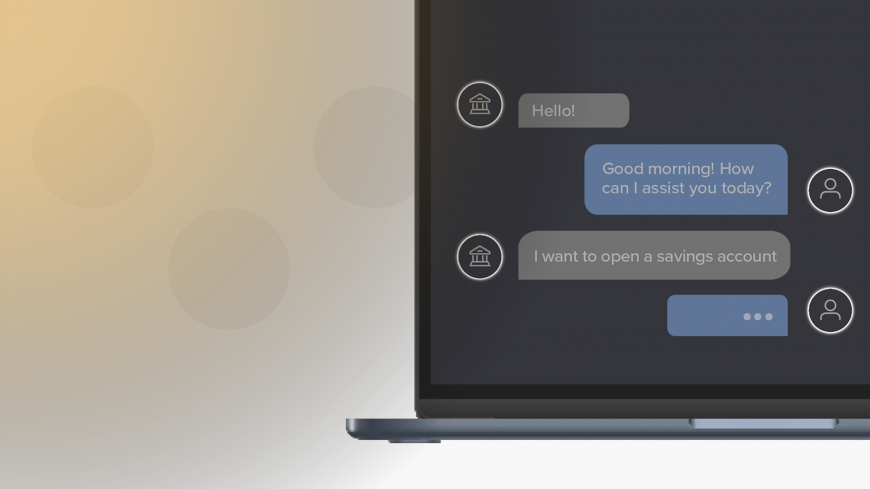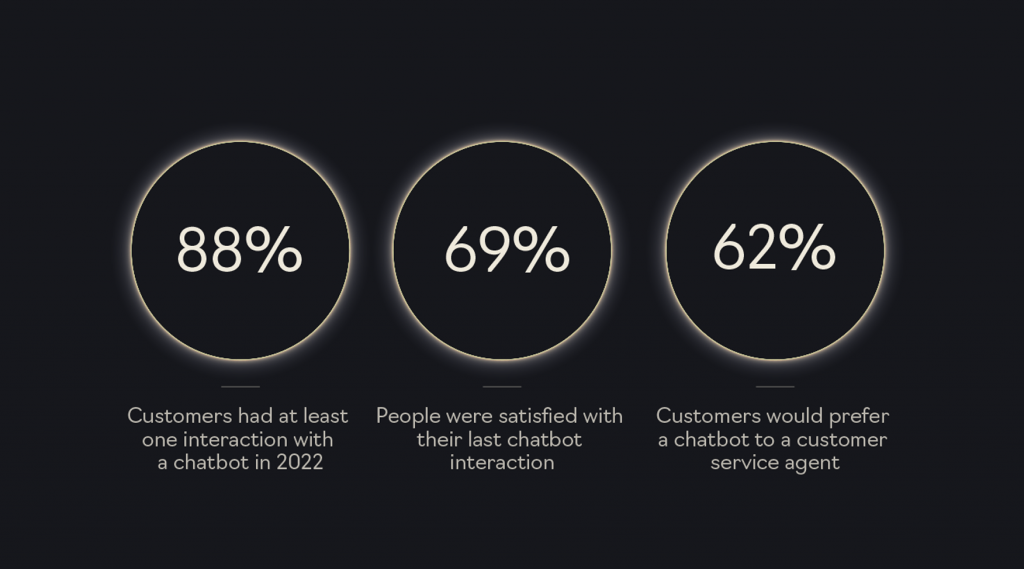Banking Chatbots and the Future of Customer Support

Think of a sector of the economy that effortlessly embraces innovation and moves with the times. Be honest, banking wasn’t the first thing that came to mind, was it? Despite being one of the few truly crucial services we regularly interact with through our smartphones, our banking apps are probably not the most exciting tiles on our home screens.
Technology is, however, the great equalizer, and the explosion in AI chatbot technology is currently leading to a quiet revolution among traditional consumer-facing businesses, particularly in the finance and banking sectors.
According to Markets and Markets, the global chatbot market was valued at $4.7 billion in 2022 and is projected to grow from $5.4 billion in 2023 to $15.5 billion in 2028. The financial services sector currently appears to be one of the key adopters of the technology. According to Grand View Research, finance is expected to be the fastest-growing sector where chatbots are concerned, with a projected compounded annual growth rate (CAGR) of 24% from 2023 to 2030.
So, what is all the fuss about? Why are chatbots quickly becoming a game changer in online banking? And why is an industry not often celebrated for breaking new ground by embracing such a transformative technology?
The Holy Grail
The ability to offer highly personalized service at scale is undoubtedly the holy grail of all businesses. Traditionally this was achieved through the use of large call center teams in combination with Customer Relationship Management (CRM) software to catalogue client interactions over time.
While many companies have mastered this approach, it’s still fundamentally limited by how many humans you have on the books. And the annoying thing about humans is that they’re only really able to handle one client interaction at a time. In other words, you can provide a personalized service, but when attempting to do so at scale, you’re pretty much stuck with how many individual homo sapiens you can corral into a call center and furnish with headsets.
Chatbots are revolutionizing customer support by promising this holy grail of personalized support to as many concurrent customers as is required.
At Devexperts, we developed Devexa – an AI virtual assistant. By leveraging machine learning and natural language processing (NLP) algorithms, she provides tailored responses to queries such as balance requests, as well as performs actions like transfers and payments, and provides recommendations based on client histories and prior interactions.
“Banks are leading the way in automating operations with chatbots. Although this journey has been challenging, chatbots have become crucial for routine tasks. Large language models have further boosted chatbot adoption, transforming customer interactions and increasing efficiency in the banking sector.
Our virtual assistant Devexa has been part of this evolution since the very start. She enhances customer interactions, bolsters sales, refines marketing tactics and boosts client loyalty. By relying on advanced tech like Devexa, banks can free up their human workforce to address more complex scenarios.”
— Evgeny Sorokin, Chief Product Officer at Devexperts
What’s great about chatbots, they can do so around the clock, which greatly extends a business’s operating hours and reduces waiting times for human agents during traditional business hours.
With all this in mind, it’s clear that front-line customer support was always going to be one of the first killer apps as chatbot technology matured. According to Juniper Research, consumers and businesses combined will save over 2.5 billion hours by 2023 in the retail, banking, and healthcare sectors.
Everyone benefits
The recent public release of several advanced Large Language Models (LLMs) such as Chat GPT has reignited a long-standing debate about artificial intelligence. The concern is that these technologies will inevitably lead to layoffs as they come to dominate what were traditionally human occupations. This is the glass half-empty view. The glass-half-full view holds that AI will lead to unforeseen increases in productivity, allowing individuals to massively multiply their own abilities by working in synergy with AI agents.
Reduce employee churn
Currently, the sorts of tasks that these agents are best equipped to perform are precisely the kinds of repetitive and uncreative tasks that actually lead to lower job satisfaction and increased employee turnover over time. Call centers are particularly subject to this, with the average employee turnover rates in the industry being between 30-45%.
So, while chatbots can be a boon to banks in terms of improved service, customer approval ratings, and cost savings, they’re also likely to increase job satisfaction among existing call center operators, who are freed from tedious interactions requiring rote responses and allowed to focus on more complex problems and queries that are genuinely useful to the business in question.
Chatbots also help reduce reliance on hiring/firing cycles that all call centers have to go through when moving from periods of peak activity to periods of relative calm. This can be a drain on the morale of staff who remain.
Prevent fraud
Integrated chatbots are also proving to be highly beneficial as fraud detection and prevention agents. The access they have to client transactions allows them to monitor for suspicious activity and can raise the alarm when potential fraud is detected.
Chatbots can be programmed to contact the customer directly, request that a transaction is approved before it goes through, or alternatively escalate the situation by involving a human agent.
Customers like them
Chatbots have been shown to work wonders for customer satisfaction. According to Tidio, 88% of respondents had at least one conversation with a chatbot in 2022. 69% of people were satisfied with their last chatbot interaction, and 62% said that they would rather interact with a chatbot rather than have to wait for a customer service agent to respond. This trend is only becoming more pronounced with younger generations. The same report showed that 56% of Gen-Z respondents think that more companies should use chatbots.
By allowing your customers to perform the transactions they currently make over the phone, online, or at their local branch through a chatbot, you’re radically modernizing your entire approach to customer service without having to materially change anything about your organizational structure or the way you ordinarily conduct business.

Customer preference data
Imagine if every single call center operator on your payroll knew every one of your customers by name, could recall details about their individual histories at will, maintained an open line of communication with them at all times, and were able to provide timely reminders regarding important pending payments and such. Furthermore, they’re also expert salespeople and are always keen to suggest an appropriate product, or even recommend switching to a better plan. This is the kind of personalized experience that chatbots are already able to provide at scale.
But where they really come into their own is the way they allow businesses to gather highly actionable customer data. Data is the lifeblood of modern businesses, which is why this is perhaps the most important benefit of employing chatbot agents.
Chatbots gather data with each interaction, becoming better able to provide appropriate responses that cover all common queries and even edge cases over time. The more frequently they’re relied on, and the more customers who interact with them, the “smarter” they become.
Most importantly, though, every interaction with a chatbot also becomes an invaluable source of client preference data. These data can then be mined by your marketing and sales departments to improve the effectiveness of their own initiatives, as well as to scan for client sentiment information regarding your products and services. These data can also be used by the chatbot itself to deliver offers and recommendations directly to the customers most likely to be interested.
The future of chatbots in banking
Chatbots are set to enjoy a very promising future in the banking industry. The sector boasts an enormous number of loyal (some might say captive) users who require access to online banking services regardless of whether a chatbot is present or not.
However, this group of users is now more likely to want to engage with non-human agents, and certain segments of it are even starting to prefer chatbot access rather than waiting around for the attention of a human customer service agent.
While many businesses have come around to the AI narrative from the LLM hype of 2023, banks have been attuned to this particular trend for some years now and have been actively working towards integrating chatbot-based customer service solutions well before ChatGPT was on anyone’s radar.
The surging interest inspired by Chat GPT, Bard, and other large language models this year has demonstrated that these models are already more than capable of effectively interacting with human beings in natural language. As these models continue to become more advanced, customer support chatbots will become more sophisticated, enabling them to handle much more complex customer queries, and perhaps act more like personal assistants than support agents.
While the human touch may never be completely replaced by artificial intelligence, it’s looking increasingly likely that at some point over the next few years, we’ll reach a tipping point where the overwhelming majority of customer support interactions are handled by chatbots rather than human beings. For those of us who’ve spent months of our lives in a call waiting queue, this tipping point couldn’t come soon enough.